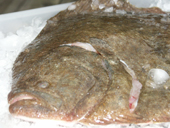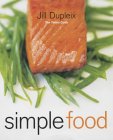
•
UK/Ireland
Canada/USA
________________________________________________________________________

eat
TURBOT
The turbot
is a large flatfish which is prized for its firm white flesh and subtle,
refined flavour. Not a cheap option, but when cooked with a few carefully
selected ingredients it makes a very fine meal indeed. For easy elegance
and purity of flavour, dishes such asTurbot in a Saffron Sauce
and Fast Roast Fish (see PICK OF THE RECIPES) are hard to beat.
HISTORY
Turbot has been held in high regard in Europe for at least two thousand years. By the eighteenth century they were being sold in Billingsgate Market, London. During much of the nineteenth century, the price they fetched at market could vary from week to week by a factor of a hundred due to the large variablility in the quantity landed by fisherman.
BIOLOGY
The turbot - Psetta maxima - is a flatfish found in the Mediterranean, the Baltic Sea and along northern European coasts to the Arctic circle. It is scaleless and its body is studded with numerous bony knobs, or tubercles. It can change colour from sandy brown to grey to match the sea bed and it feeds on other bottom-dwelling fishes and crustaceans.
NUTRITION
Turbot is a very good source of protein, and vitamins B3 and B12. It also contains the minerals selenium (important for immune system functioning), magnesium (plays a part in metabolism) and phosphorous (helps build strong bones and teeth).
TIPS
BUYING
Small turbot will yield unsatisfyingly thin fillets (and are to be avoided
from a marine conservation standpoint) whilst very large turbot often
have slightly tough, thready flesh. Middling-sized turbot, roughly 2½
to 3½ kg, are the most desirable. Look for bright, unsunken eyes
and smell for seawater freshness.
STORING
In the fridge for up to 24 hours, or freeze for up to 3 months.
PREPARING
Steaming, poaching, shallow-frying, baking and grilling are all suitable
cooking methods for turbot fillets. If grilling, brush with butter and
leave the skin on to help retain moistness. To bake, season the fish and
wrap in foil parcels with some fresh herbs, and a little white wine and/or
stock. When cooking good fresh turbot, elaborate flavourings or accompaniments
are wholly unnecessary.
The fins and bones make an excellent fish stock.
OTHER STUFF
From The Book of Household Management (Isabella Beeton):
An amusing anecdote is related, by Miss Edgeworth, of a bishop, who, descending to his kitchen to superintend the dressing of a turbot, and discovering that his cook had stupidly cut off the fins, immediately commenced sewing them on again with his own episcopal fingers. This dignitary knew the value of a turbot’s gelatinous appendages.
PICK OF THE RECIPES
in
season:
january
february
march
april
may
june
july
august
september
october
november
december
Central London
locale
Pastry, pasta,
puds and lots more!
Fun and deliciously
different
www.cookeryschool.co.uk

A
contract catering
company that puts
quality and freshness first
www.artizian.co.uk
ONLINE
IN PRINT
-
Ceviche with Hot Garlic Potatoes
How to Eat: Pleasures and Principles of Good Food -
Baked Fish with Herbs
Twelve -
Fast Roast Fish
Simple Food
© 2004-2010 eat the seasons | contact @ eattheseasons.co.uk | about

